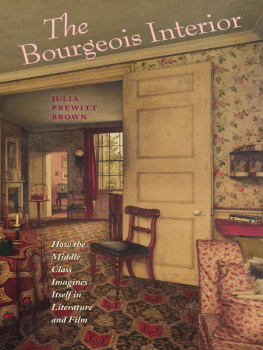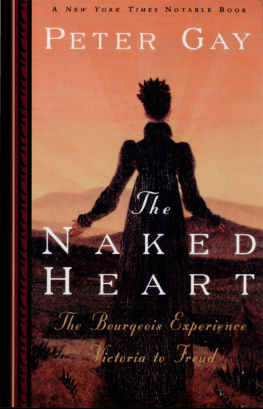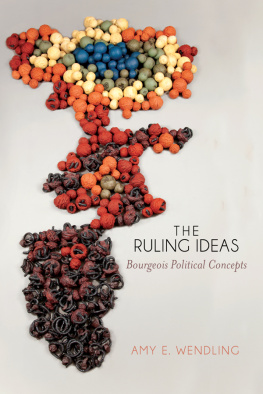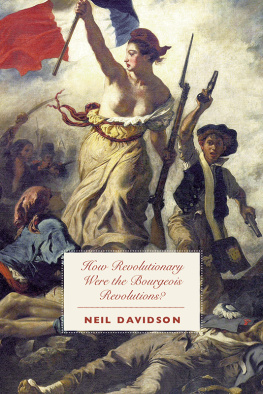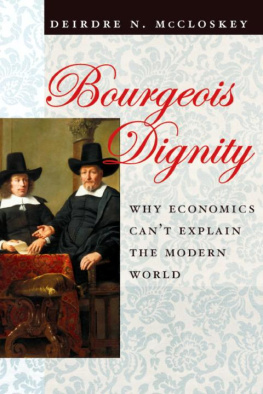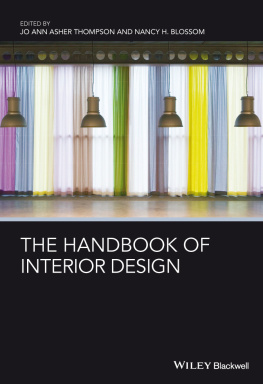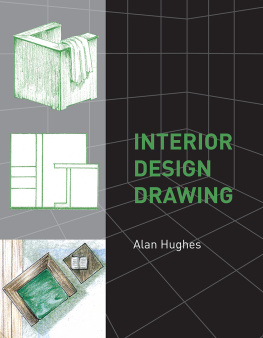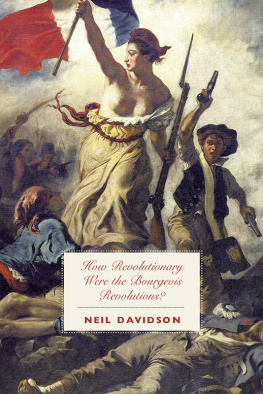Brown - The Bourgeois Interior
Here you can read online Brown - The Bourgeois Interior full text of the book (entire story) in english for free. Download pdf and epub, get meaning, cover and reviews about this ebook. City: Charlottesville, year: 2012, publisher: University of Virginia Press, genre: Science. Description of the work, (preface) as well as reviews are available. Best literature library LitArk.com created for fans of good reading and offers a wide selection of genres:
Romance novel
Science fiction
Adventure
Detective
Science
History
Home and family
Prose
Art
Politics
Computer
Non-fiction
Religion
Business
Children
Humor
Choose a favorite category and find really read worthwhile books. Enjoy immersion in the world of imagination, feel the emotions of the characters or learn something new for yourself, make an fascinating discovery.
- Book:The Bourgeois Interior
- Author:
- Publisher:University of Virginia Press
- Genre:
- Year:2012
- City:Charlottesville
- Rating:3 / 5
- Favourites:Add to favourites
- Your mark:
- 60
- 1
- 2
- 3
- 4
- 5
The Bourgeois Interior: summary, description and annotation
We offer to read an annotation, description, summary or preface (depends on what the author of the book "The Bourgeois Interior" wrote himself). If you haven't found the necessary information about the book — write in the comments, we will try to find it.
Brown: author's other books
Who wrote The Bourgeois Interior? Find out the surname, the name of the author of the book and a list of all author's works by series.
The Bourgeois Interior — read online for free the complete book (whole text) full work
Below is the text of the book, divided by pages. System saving the place of the last page read, allows you to conveniently read the book "The Bourgeois Interior" online for free, without having to search again every time where you left off. Put a bookmark, and you can go to the page where you finished reading at any time.
Font size:
Interval:
Bookmark:

The Bourgeois Interior

Bourgeois
Interior
JULIA
PREWITT
BROWN
University of Virginia Press
CHARLOTTESVILLE AND LONDON
University of Virginia Press
2008 by the Rector and Visitors of the University of Virginia
All rights reserved
Printed in the United States of America on acid-free paper
First published 2008
9 8 7 6 5 4 3 2 1
LIBRARY OF CONGRESS CATALOGING-IN-PUBLICATION DATA
Brown, Julia Prewitt, 1948
The bourgeois interior / Julia Prewitt Brown.
p. cm.
Includes bibliographical references and index.
ISBN 978-0-8139-2710-7 (acid-free paper)
1. English fictionHistory and criticism. 2. Middle class in literature. 3. Interior decoration in literature. 4. Dwellings in literature. 5. Middle class in art. 6. Interior decoration in art. 7. Dwellings in art. 8. American fictionHistory and criticism. I. Title.
PR 830. M 53 B 76 2008
820.9 355dc22 | 2008003089 |
For Howard Eiland
Contents
Illustrations
Preface
No one likes to think of himself as bourgeois. Yet the signs of bourgeois society are all around us. We have only to examine the array of home magazines on display in any drugstore, from bargain basement, do-it-yourself decorating magazines to catalogs of luxury estates, to be reminded of the ubiquity of bourgeois values. Embourgeoisement, or the process by which all classes come to identify with the interests and aspirations of the middle class, is apparent throughout our society, from a laboring class with substantial pension funds invested in Wall Street to an upper class with socioeconomic aspirations very similar to those of the middle class. (Consider the wedding pages of the New York Times.) In the conclusion to this work, I refer to the present or technological age as an afterlife of the nineteenth-century bourgeoisie, or one in which old-bourgeois myths are still pervasive.
A few decades ago Roland Barthes defined the bourgeoisie as the social class which does not want to be named. This flight from the word bourgeois, he insisted, is not accidental: it is bourgeois ideology itself, the process by which bourgeois norms are experienced as the evident laws of natural order.a bourgeois value par excellence, which is not to say that comfort is always comforting. One has only to buy a mattress to make this discovery. In the sales literature for mattresses, the words pain and sleeplessness appear almost as frequently as the word comfort, as if everyone who bought a mattress is seeking relief from insomnia and muscular pain. In bourgeois society, the pursuit of comfort is itself a sign of agitation and unrest.
This book does not aim to unmask the bourgeois. It aims to focus attention on the mask itself, or on the protective material expressions of bourgeois life. Neither is it a materialist study of bourgeois things. Catalogs of objects figure in histories of bourgeois culture like Asa Briggss Victorian Things, but they are of interest here only in so far as the bourgeois himself loves to catalog his things. To the bourgeois, objects are alive, which is something he has in common with the child. No work illustrates this point more movingly than Walter Benjamins Berlin Childhood around 1900.
To grasp the elusive concept of bourgeois in the contemporary context, I made myself into a kind of suburban flneur. The American suburbs are far from possessing the phantasmagoric variety of the famed nineteenth-century flneurs stomping ground, Paris, but they have plenty to occupy the attention of anyone interested in understanding what it means to be bourgeois. In combing real estate ads, attending open houses, and taking long walks where sidewalks were available, I was often reminded of the Latin root of the word bourgeois, which is burgus, meaning fortress. Elaborate security systems, invisible fences, and granite kitchens are prime selling features of suburban real estate. Yet like that of the mattresses with their discomfiting literature about steel metal coils, the ostensible goal of these dwellings is comfort. Only after this initial stage of exploration was I able to approach the literary subject of the book, a fact that I bore in mind when I added contemporary references. I am convinced that whatever is both amusing and profound, both charming and disturbing, about the bourgeois domestic interior in literature is more readily grasped by a reader who is alive to the present in the past, the past in the present.
In discussing selected works of literary and visual art, I more often use the words bourgeois imagination of life than bourgeois ideology for a reason. Its not simply that the richness of these works, their intrinsic variety and texture, is greater than the promulgation of ideology allows for. (Compare, for example, the endlessly renewed complexity of Vermeers The Love Letter, reproduced on page 7, with the strident ideographs of country cottages by Thomas Kinkade on sale in shopping malls throughout America.) Its that I share the skepticism of historians like J. G. A. Pocock in recognizing that bourgeois ideology is itself a problematic concept. In his analysis of the tension between virtue and commerce in the eighteenth century, Pocock insists that there is no greater and no commoner mistake in the history of social thought than to suppose that the tension ever disappeared, and that the ideals of virtue and unity of personality were driven from the field, or that a commercial, liberal or bourgeois ideology reigned undisturbed until challenged by the harbingers of Marx. According to Pocock, there has always been an ambivalent dialogue over the emergence of bourgeois norms. I have tried to be attentive to this ambivalence throughout my discussion.
I would like to acknowledge the following people and institutions for their generous support of this project. Cathie Brettschneider, Humanities Editor at the University of Virginia Press, has been a joy to work with. The two anonymous readers at the press gave tactful and discerning recommendations for revision. David Thorburn and James Winn were extremely generous with their time, encouragement, and wise insight. Bonnie Costello, Marcia Folsom, Carol McGuirk, Susan Mizruchi, Lee Monk, Barbara Schapiro, Steven Tapscott, Sandra Tropp, and Elizabeth Yates read parts of an earlier draft and gave invaluable suggestions. For inspiring conversation about the questions raised in the book, I would like to thank Elizabeth Brown, Ruah Donnelly, Susan Jackson, Margery Kirber, Leshan Kwan, Naomi Miller, and Swen Voekel. For the illustrations I am grateful to the Rijksmuseum, Amsterdam; the Swedish Film Institute, Svensk Filmindustri; and the Museum of Fine Arts, Boston.
My greatest debt is to my husband, Howard Eiland. As Mr. Pickwick says to Mr. Perker: You have done me many acts of kindness that I can never repay, and have no wish to repay, for I prefer continuing the obligation.
The Bourgeois Interior
Introduction
Look around this room of yours, and what do you see? John Ruskin posed this question to bourgeois readers in 1853. How would middle-class readers answer it today?
Standing at the outside of a typical bourgeois residence in suburban Boston in 2006, we are likely to see evidence of a security system, perhaps in the form of a small red light near the entrance, and a plaque identifying the company that designed the system. A peephole in the door makes it possible for the dweller to view the outside world through a distorting lens. As in Robinson Crusoes island fortressthe first bourgeois interior in English fictiona surveillance and warning system protects against unlawful entry. The name of a security service in the metropolitan area would have appealed to Robinson Crusoe: Absolute Security, Inc.
Next pageFont size:
Interval:
Bookmark:
Similar books «The Bourgeois Interior»
Look at similar books to The Bourgeois Interior. We have selected literature similar in name and meaning in the hope of providing readers with more options to find new, interesting, not yet read works.
Discussion, reviews of the book The Bourgeois Interior and just readers' own opinions. Leave your comments, write what you think about the work, its meaning or the main characters. Specify what exactly you liked and what you didn't like, and why you think so.

